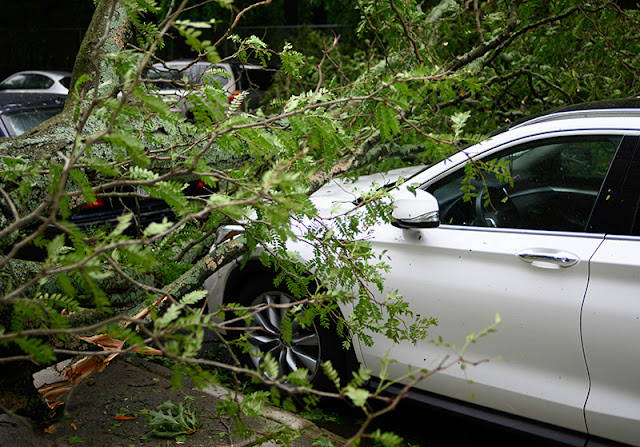From minor fender benders to devastating fatal crashes, understanding the different types of car accidents is crucial. While some incidents result in mere dents and scratches, others lead to life-altering consequences. By recognizing the varying degrees of severity, drivers can prioritize safety measures and navigate the roads with heightened caution. Whether it's a rear-end collision or a T-bone impact, each type demands specific attention and awareness behind the wheel. Stay informed to protect yourself and others on the road.
Understanding Car Accident Types
Head-On Collisions
Head-on collisions occur when two vehicles traveling in opposite directions crash into each other. These accidents often result in severe injuries and fatalities due to the high impact forces involved.
In head-on collisions, the front ends of both vehicles absorb most of the impact, leading to devastating damage to the cars and significant injuries to the occupants. The force generated in these accidents can cause traumatic head injuries, spinal cord damage, and even death.
Odd-Angle Collisions
Odd-angle collisions, also known as side-impact or T-bone collisions, happen when the front of one vehicle strikes the side of another at an angle. These types of accidents pose a high risk of serious injuries, especially to passengers on the impacted side.
Odd-angle collisions often occur at intersections or when one driver fails to yield the right of way. The lack of protection on the sides of vehicles makes occupants vulnerable to direct impact forces, leading to injuries like broken bones, internal organ damage, and head trauma.
Rear-End Collisions
In rear-end collisions, one vehicle crashes into the back of another. While these accidents are common at lower speeds, they can still cause significant harm. Whiplash is a typical injury resulting from rear-end collisions due to the sudden jerking motion upon impact.
Whiplash occurs when the neck muscles extend beyond their normal range of motion, causing pain and stiffness. Rear-end collisions can lead to back injuries, such as herniated discs or spinal fractures.
Causes Behind Car Accidents
Distracted Driving
Distracted driving accidents often result from texting, eating, or using a phone while driving. Consequences include rear-end collisions, side-swiping, and even fatal crashes. These accidents are preventable with focused attention on the road.
Drowsy Driving
Drowsy driving accidents stem from lack of sleep, causing slower reaction times and impaired judgment. The risks involve veering off the road, hitting other vehicles, or even causing rollover crashes. To avoid such accidents, drivers should prioritize getting enough rest before driving.
High-Speed Crashes
High-speed crash accidents significantly impact road safety by increasing the severity of injuries and fatalities. These crashes often lead to extensive vehicle damage, multiple-car collisions, and pose a higher risk to pedestrians and cyclists. Drivers exceeding speed limits endanger not only themselves but also others on the road.
Impact and Outcome of Collisions
T-Bone Collisions
T-Bone collisions, occurring at intersections, are particularly severe. The side of a vehicle gets directly hit, leading to significant crash impact.
T-Bone accidents often result in serious injuries due to the lack of protection on the sides of vehicles. These collisions can lead to fatalities, especially when the point of contact is near the driver or passenger doors.
Influence of Impact Location
The location of impact plays a crucial role in determining the severity of a collision. For instance, rear-end collisions usually result in minor injuries due to the crumple zones designed to absorb impact.
On the other hand, head-on collisions are among the most dangerous as they involve two vehicles colliding front-to-front. Such crashes often lead to catastrophic outcomes, including fatalities and severe injuries.
Potential Outcomes
The outcome of car accidents varies greatly depending on factors like speed, vehicle size, and type of collision. From minor fender benders causing slight damage to fatal crashes resulting in loss of life, each accident type has its own set of potential consequences.
Understanding these outcomes is crucial for promoting safer driving practices and implementing effective books on road safety measures.
Driver and Vehicle Factors
Teen Drivers
Teen driver accidents often result from inexperience and reckless behavior like speeding or distracted driving. These factors contribute to a higher rate of fender benders among young drivers.
Elderly Drivers
Elderly driver accidents are commonly linked to diminished vision, slower reaction times, and medical conditions affecting driving ability. Such factors can lead to severe collisions on the street.
Rideshare Accidents
Legal cases involving rideshare accidents can be complex due to issues like determining liability between drivers, passengers, and the rideshare company. The involvement of multiple parties often complicates the legal information needed for a successful case.
Teen driver accidents:
Lack of experience
Reckless behavior
Elderly driver accidents:
Diminished vision
Slower reaction times
Legal Concerns Post-Accident
Rental Car Accidents
Rental car accidents can lead to complex legal scenarios, as both the driver and the rental company may share liability. In such cases, understanding the compensation process is crucial.
Post-Accident Legal Concerns
After a car accident, legal concerns vary based on the severity of the incident. From minor fender benders to fatal crashes, compensation claims and insurance negotiations become critical.
Driver and Vehicle Owners' Responsibilities
Drivers and vehicle owners hold distinct legal responsibilities post-accident. Drivers must report the incident to authorities promptly, while vehicle owners need to ensure their insurance covers all potential liabilities.
Final Remarks
You now have a comprehensive understanding of various car accident types, their causes, impacts, driver and vehicle factors, and legal considerations. It's crucial to stay informed and cautious on the road to prevent accidents and ensure your safety. Remember, being a responsible driver not only protects you but also others sharing the road with you. Stay vigilant, follow traffic rules, and maintain your vehicle to reduce the risk of accidents.
As you reflect on the information provided, consider sharing these insights with friends and family to raise awareness about safe driving practices. Your actions can make a significant difference in preventing accidents and promoting road safety for everyone. Stay informed, stay safe, and drive responsibly.
Frequently Asked Questions
What are the common types of car accidents?
Different types include rear-end collisions, side-impact crashes, rollovers, and head-on collisions. Each has unique characteristics impacting severity and injuries.
How do driver factors contribute to car accidents?
Driver factors like speeding, distraction, fatigue, and impairment significantly increase accident risks. Safe driving practices and adherence to traffic laws are crucial.
What legal concerns should I consider after a car accident?
Legal issues post-accident involve insurance claims, fault determination, liability disputes, and potential lawsuits. Seeking legal advice can help navigate complex legal processes effectively.
Why is understanding the impact and outcome of collisions important?
Understanding collision outcomes helps in assessing injuries, property damage, and financial implications. It aids in making informed decisions regarding medical treatment, repairs, and insurance claims.
Can vehicle factors lead to car accidents?
Vehicle factors such as mechanical failures, poor maintenance, or defective parts can contribute to accidents. Regular maintenance checks and prompt repairs can prevent potential hazards on the road.








0 Comments